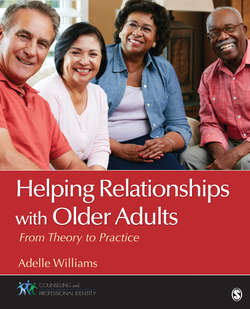Читать книгу Helping Relationships With Older Adults - Adelle M. Williams - Страница 76
На сайте Литреса книга снята с продажи.
Exercise
ОглавлениеExercise is extremely beneficial in all stages of life. Much of older adults’ physical decline stems not from age but from disuse. When they sit all day, year after year, their bones, muscles, and organ systems atrophy, and their self-confidence wanes. However, the ability of exercise to revitalize and invigorate older adults’ lives is now a proven fact (Manson et al., 2002). Reichstadt and colleagues (2010) found that 50% of assisted living community residents reported exercising regularly. Physiological (e.g., glucose level regulation, balance, and coordination), psychological, and social (empowerment, social and cultural integration) benefits of physical activity also foster successful aging (Chodzko-Zajko, Schwingel, & Park, 2009). Guided Practice Exercise 3.3 provides the opportunity to identify benefits associated with exercising and address modifications needed for exercise prescription for older persons.
Guided Practice Exercise 3.3
There are tremendous benefits associated with exercise. Guidelines exist that identify the type and frequency of exercises necessary for healthy functioning for older persons. List the types of exercises and benefits of exercises you are familiar with. Now examine how these exercises may need modification for older adults with chronic medical conditions. Share this information with your peers and professional colleagues.
Exercise regimens that build muscle produce a cascade of positive health effects. Rebuilding and maintaining strength helps to preserve aerobic capacity, keep blood pressure low, retain a healthy blood-sugar tolerance, maintain healthy cholesterol, sustain mineral density of the bones, and stabilize the body’s ability to regulate its internal temperature. Guided Practice Exercise 3.4 illustrates the role of exercise in preventing the development of a chronic disease.
Guided Practice Exercise 3.4
An elderly woman maintained her appointment with her primary care physician (PCP) who reported that she had “osteopenia,” a precursor to osteoporosis. Her PCP recommended strength training 3 times per week for 6 weeks. She complied, and upon examination, her PCP reported that she exhibited no signs of osteopenia. She was delighted and continued with her regular strength training sessions. Research other older persons with health conditions and examine how they used exercise to improve their health challenges.
Aerobic capacity (also called maximal oxygen intake or work capacity) is a fundamental measure of the cardiopulmonary system, made up of the heart, lungs, and circulatory mechanisms. Simply put, aerobic capacity is the body’s ability to process oxygen. It includes the ability to breathe air into the lungs for aeration of the blood and the ability to transport oxygen effectively to all parts of the body through the bloodstream. By age 65, the average American has lost 30 to 40% of his or her aerobic capacity—and the health of his or her entire cardiovascular system.
Another biomarker for physiological aging that can be reversed by regular exercise is glucose tolerance and insulin sensitivity. For most people, the body’s ability to use glucose in the bloodstream declines with age. As people develop more body fat and less muscle, their muscle tissue becomes less and less sensitive to insulin. As a consequence, it takes more and more insulin to have the desired effect. Increasing the muscle-to-fat ratio can reverse this deterioration, improve the blood-sugar tolerance, keep the insulin sensitivity high, and greatly reduce the chances of developing diabetes.
Improving fitness level, especially if one is sedentary, can enhance functional years. As the body ages, it loses muscle mass. The less muscle it has, the less energy it will burn even while resting. The lower a person’s metabolic rate, the more likely he or she will gain weight. Regular strength training can increase muscle mass, boost metabolism, strengthen bones, prevent osteoporosis, and in general, make one feel better and function more efficiently (Nelson, Rejeski, Blair, Duncan, & Judge, 2007). Both aerobic and muscle strengthening activities are critical for healthy aging. Basic recommendations for aerobic and strength training exercises in older adults include moderately intense aerobic exercise for 30 minutes 5 days a week or vigorous intense aerobic exercise for 20 minutes 3 days a week as well as 8 to 10 strength training exercises with 10 to 15 repetitions of each exercise 2 to 3 times per week (Nelson et al., 2007). In addition, the American College of Sports Medicine (ACSM) and the American Heart Association (AHA) recommend that older adults or adults with chronic conditions develop an activity plan with a health professional to manage risks and take therapeutic needs into account. This will maximize the benefits of physical activity and ensure safety. Case Illustration 3.2 identifies the significance of exercise for an elderly woman with major health problems.
Case Illustration 3.2
Mrs. Morris is a happily married 67-year-old female who lives in a four-story home with her spouse. She has suffered from various forms of cancer, received treatment, and has been considered in remission. Her outlook is usually positive; however, she worries a great deal about her daughter, who has developed a rare disease of unknown etiology. She frequently accompanies her to her physician appointments and also assists with paying for these medical services.
Unfortunately, she has been unable to attend the “Silver Sneakers” classes that she enjoyed, and she is not taking adequate care of herself. Her cancer has re-emerged, and she is receiving chemotherapy treatment, which she is optimistic will help, as it has in the past. When she exercised, her mood improved, her body was toned, and she completed all activities of daily living with ease. Despite her recent recurrence of cancer, she appears to be more concerned with getting back to the health club. She reported that she developed relationships there, had something to look forward to, and felt good because she was able to stay mentally sharp. Exercise had become an integral component of her life.
